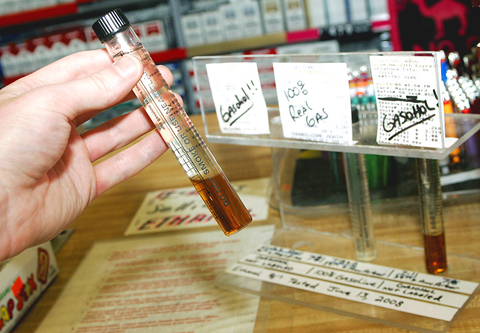“Why Do You Put Alcohol in Your Tank?” demands a large sign outside one gas station here, which reassures drivers that it sells only “100% Gas.”
“No Corn in Our Gas,” advertises another station nearby.
Along the highways of this sprawling prairie city, and in other pockets of the country, a mutiny is growing against energy policies that heavily support and subsidize the blending of ethyl alcohol, or ethanol, into gasoline.

PHOTO: NY TIMES NEWS SERVICE
Many consumers complain that ethanol, which constitutes as much as 10 percent of the fuel they buy in most states, hurts gas mileage and chokes the engines of their boats and motorcycles.
As ethanol has spread around the country, gas station owners and wholesalers are catering to concerns about ethanol that are often exaggerated but not entirely unfounded. High gas prices seem to be helping them plant seeds of doubt in customers’ minds.
“We just think it’s better for the car — we get better mileage,” said Marjorie Olbert, a retired teacher, as she filled her 2002 Toyota with what is sometimes called conventional or “clear” gasoline at a suburban E-Express station.
Stickers on the pump urge customers to “Always Demand 100% Real Gasoline.”
Olbert was unmoved by the slightly lower price of the blend.
“My husband and I just decided that the few cents difference is worth it,” she said.
Though common in the Midwest for at least a decade, ethanol-gas blends — often called gasohol — arrived on the coasts a few years ago and only recently started showing up in many southern states.
The expansion has been driven largely by federal measures requiring that 136 billion liters of biofuels a year be mixed into the nation’s gasoline supply by 2022. Last year, 25 billion liters of ethanol were mixed into a supply of 538 billion liters of gasoline.
Several states mandate ethanol blends, now found in two-thirds of the nation’s gas supply. Florida recently passed a requirement that will take effect in 2010.
Ron Lamberty of the American Coalition for Ethanol estimates that about a quarter of all gas stations across the country sell only ethanol blends, a quarter sell only unblended gas, and the other half offer both, or go back and forth depending on price.
Mike Brown, a vice president of Harris Oil, a wholesaler north of Orlando, has stuck to unblended gas, which he shuttles to large businesses like marinas and landscapers, even as many of his competitors switched to ethanol blends in May, after the changeover of a large supply terminal.
He used to deliver three or four tanker loads a week, but “we’ve added an extra load because of our new customers,” he said.
He also has a small fueling station where customers are starting to bring 19 liter gasoline cans or 208 liter drums to get their hands on ethanol-free gasoline.
The most common blend of ethanol is called E10, which is about 90 percent gasoline and 10 percent ethanol by volume. All modern nondiesel cars are certified to run on a blend of up to 10 percent.
(E85, a much higher ethanol blend of about 85 percent ethanol and 15 percent gasoline, is only for vehicles specifically designated “flex fuel.”)
Liter for liter, pure ethanol contains one-third less energy than gasoline, and the ethanol industry acknowledges that E10 reduces mileage by about 2 percent.
Some drivers think the change is greater. Chuck Mai, a vice president of AAA Oklahoma, reported that members of his organization have been blaming E10 for mileage drops of 8 percent to 20 percent.
Drivers in Tulsa, he said, are complaining to their service stations, saying: “‘I used to get 28 miles per gallon [12km per liter]; last time around, I’m getting 25 [10.6km per liter]. What’s going on?’”
In chat rooms at Edmunds.com and elsewhere, plenty of people are blaming ethanol for substantial mileage drops.
Auto drivers are not the only ones complaining.
Ashley Massey, a spokeswoman for the State Marine Board in Oregon, where an E10 mandate is being enforced this year, said that when E10 first arrived, her agency was flooded by calls.
“What we’re hearing is that the boats are starting, but then they start to sputter” and quit, she said.
They are also hard to restart, Massey said, adding that her own weed trimmer sputtered and died with E10, but revived with conventional gas.
Her agency has posted a list of gas stations that still sell unblended fuel, as permitted by exemptions to Oregon’s mandate, on its Web site. Warnings and tips about using E10 are included as well.
Mechanics for a range of equipment and small vehicles, from boats and motorcycles to lawnmowers, have blamed E10 for engine sputters and shutdowns.

MORE VISITORS: The Tourism Administration said that it is seeing positive prospects in its efforts to expand the tourism market in North America and Europe Taiwan has been ranked as the cheapest place in the world to travel to this year, based on a list recommended by NerdWallet. The San Francisco-based personal finance company said that Taiwan topped the list of 16 nations it chose for budget travelers because US tourists do not need visas and travelers can easily have a good meal for less than US$10. A bus ride in Taipei costs just under US$0.50, while subway rides start at US$0.60, the firm said, adding that public transportation in Taiwan is easy to navigate. The firm also called Taiwan a “food lover’s paradise,” citing inexpensive breakfast stalls

TRADE: A mandatory declaration of origin for manufactured goods bound for the US is to take effect on May 7 to block China from exploiting Taiwan’s trade channels All products manufactured in Taiwan and exported to the US must include a signed declaration of origin starting on May 7, the Bureau of Foreign Trade announced yesterday. US President Donald Trump on April 2 imposed a 32 percent tariff on imports from Taiwan, but one week later announced a 90-day pause on its implementation. However, a universal 10 percent tariff was immediately applied to most imports from around the world. On April 12, the Trump administration further exempted computers, smartphones and semiconductors from the new tariffs. In response, President William Lai’s (賴清德) administration has introduced a series of countermeasures to support affected

CROSS-STRAIT: The vast majority of Taiwanese support maintaining the ‘status quo,’ while concern is rising about Beijing’s influence operations More than eight out of 10 Taiwanese reject Beijing’s “one country, two systems” framework for cross-strait relations, according to a survey released by the Mainland Affairs Council (MAC) on Thursday. The MAC’s latest quarterly survey found that 84.4 percent of respondents opposed Beijing’s “one country, two systems” formula for handling cross-strait relations — a figure consistent with past polling. Over the past three years, opposition to the framework has remained high, ranging from a low of 83.6 percent in April 2023 to a peak of 89.6 percent in April last year. In the most recent poll, 82.5 percent also rejected China’s

PLUGGING HOLES: The amendments would bring the legislation in line with systems found in other countries such as Japan and the US, Legislator Chen Kuan-ting said Democratic Progressive Party (DPP) Legislator Chen Kuan-ting (陳冠廷) has proposed amending national security legislation amid a spate of espionage cases. Potential gaps in security vetting procedures for personnel with access to sensitive information prompted him to propose the amendments, which would introduce changes to Article 14 of the Classified National Security Information Protection Act (國家機密保護法), Chen said yesterday. The proposal, which aims to enhance interagency vetting procedures and reduce the risk of classified information leaks, would establish a comprehensive security clearance system in Taiwan, he said. The amendment would require character and loyalty checks for civil servants and intelligence personnel prior to